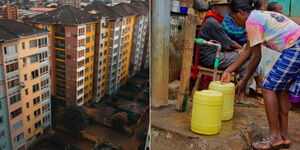Nairobi landlords and developers have shifted focus from building houses containing wide rooms and more spaces as the demand for houses increases, land space diminishes and the cost of living rises. Land rates also rose between 2009 and 2020.
A report by the Kenya National Bureau of Statistics (KNBS) 2020 detailed that Nairobi houses are becoming smaller as landlords rush to attract tenants.
The developers target low-income earners who are flooding the city to make ends meet and also raising the population of the county. Most of those who afforded two-bedroom houses and above were also hit hard by the Covid-19 pandemic.
Landlords are therefore constructing single-rooms, bedsitters and one-bedroomed houses that are appealing to the masses. These affordable houses enable tenants to pay rent and also pay for commodities and satisfy their basic needs.
In 2019, 3,940 one-room units were built in Nairobi. This accounts for an 84 percent increase from the 2,135 developed in 2015, KNBS says.
In 2015, Nairobi had over 693 rental buildings containing six rooms and above. However, this reduced to around 442 in 2019.
Landlords argued that the price and demand for land also rose, forcing developers to construct flats rather than standalone permanent houses. This enables them to maximise income.
Developers argued that attracting tenants ensured one recouped the money spent to buy land and construct houses within a few years. This also enabled them to offset loans and make profit years later.
A caretaker in 87 Estate near Uthiru, Nairobi, said that his landlord was contemplating demolishing a number of his standalone houses built in 2008 to construct multi-storied houses.
"That is the new way to go. The demand for affordable housing is big. In this location, single rooms go for as low as Ksh 3,000, bedsitters average between Ksh 6,500 and Ksh 10,000 with one bedroom houses trading at Ksh 18,000," he said and asked for his identity to be reserved.
Nairobi's Eastlands attracts most of the city's middle class and low-income earners and a spot check in the area disclosed that houses go for as low as Ksh 7,000 for bedsitters and Ksh 3,000 for single rooms.
Landlords were also forced to slash rents so as to attract tenants in suburb areas as many opted for cheaper houses in Eastlands. Speaking to Kenyans.co.ke, a tenant residing in Kileleshwa revealed that she was able to negotiate her rent down by Ksh 20,000.
"I used to pay Ksh75,000 for my 2-bedroomed apartment but we came to an understanding with my landlord who agreed to bring it down to Ksh55,000. Last year, almost 50 percent of my neighbours moved out due to the pandemic and tough economic constraints that followed. With most of the houses vacant for months, I saw this as an opportunity to renegotiate," she explained.
A report by Knight Frank in December 2020 said that a majority of Kenyans would relocate to cheaper rental houses, or sell their homes to buy cheaper ones in 2021. The demand for apartments also declined, with 50 percent of respondents indicating that they are less likely to want to live in an apartment in the future.
The Kenya Bankers Association (KBA) on Monday, November 9, published the Housing Price Index (HBI) report for the third quarter of 2020 (Q3 2020) disclosing that although house prices growth were stabilising amid weakened demand and supply, the growth remained in the negative territory.
The prices of houses in Athi River, Machakos, Kiambu and Nairobi dropped.
In 2020, the government was under pressure to freeze rent payment at the onset of the Coronavirus pandemic. However, demand for cheaper houses has forced landlords to waver rent and those who had wavered in 2020 have not yet increased their rent demands.












